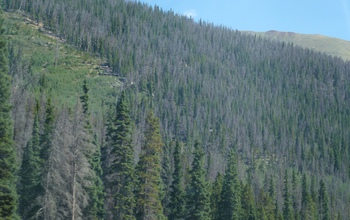Impacts of drought, heat, beetle infestations on forests go far beyond local landscape
 Dead trees west of Denver, Colorado, killed by a combination of drought and beetle infestations. Credit and Larger Version |
November 16, 2016
This is the eighth in a series on NSF's MacroSystems Biology Program. Please also visit numbers one, two, three, four, five, six and seven.
Major forest die-offs due to drought, heat, beetle infestations or deforestation could have consequences far beyond the local landscape, results from a new study show.
According to a paper published today in the journal PLOS ONE, wiping out an entire forest can have significant effects on global climate patterns and alter vegetation on the other side of the world. The study was funded by the National Science Foundation (NSF)'s MacroSystems Biology Program.
"This research shows that local events like forest die-offs in one part of the globe influence climate and ecology in other, often distant locations," said Tim Kratz, NSF program director for MacroSystems Biology. "Unraveling these far-reaching effects is critical to understanding how nature works at continental to global scales."
Similar to El Niño effects
Similar to how El Niño - the weather phenomenon in the tropical Pacific Ocean characterized by warm ocean temperatures - can affect global weather patterns, the ramifications of forest loss extend far beyond the local area. Forest loss can even affect distant plants.
"When trees die in one place, it can be good or bad for plants elsewhere, because it causes changes in one place that can ricochet to shift climate in another place," said Elizabeth Garcia, a University of Washington atmospheric scientist and the paper's lead author. "The atmosphere provides the connection."
Scientists have a clear understanding about certain local effects of deforestation. For example, forest loss has a localized cooling effect, as treeless surfaces absorb less sunlight. The loss of vegetation also makes air drier.
The new study describes how major forest losses can alter global climate by shifting the path of large-scale atmospheric waves or changing the amount of sunlight absorbed in the Northern versus the Southern hemispheres. Such changes can shift tropical rain bands and other climate features.
"People have thought about how forest loss matters for an ecosystem, and maybe for local temperatures, but they haven't thought about how that interacts with the global climate," said paper co-author Abigail Swann, an atmospheric scientist and biologist at the University of Washington. "We are only starting to think about these larger-scale implications."
Far-apart regions linked
Researchers ran a climate model with a drastic forest-loss scenario on two areas currently losing trees: western North America, a region stretching from the southwestern U.S. to Alaska that suffers from drought, heat and beetle infestations, and the Amazon rainforest, which has experienced decades of intense human development.
The results showed that tree loss in western North America caused cooling and slow forest growth in Siberia. That same tree loss made the air drier in the southeastern U.S., harming forests in regions like the Carolinas. Forests in South America benefited from the tree loss, however, with areas south of the equator becoming cooler and wetter.
In the second simulation, removing most of the Amazon rainforest also caused Siberia to become colder and more barren, but it had a slight positive effect on forest growth in the southeastern U.S.
Forest loss in the Amazon also significantly affected neighboring forests in eastern South America -- mostly by increasing the precipitation there during the Southern Hemisphere summer.
"It's really interesting that these effects happen through different mechanisms, depending on where you look," Swann said.
The model's parameters for forest changes are still preliminary, so researchers have not yet produced exact cause-and-effect mapping for each location.
The researchers are conducting field studies to better characterize the temperature and humidity changes from altering different forest types. They also hope to pinpoint which locations are most sensitive to triggering such shifts, or to being affected by the changes.
Other paper co-authors are: Juan Villegas at the University of Antioquia in Colombia; David Breshears, Darin Law and Scott Saleska at the University of Arizona; and Scott Stark at Michigan State University. The study was also funded by the U.S. Department of Energy.
-NSF-
Media Contacts Cheryl Dybas, NSF, (703) 292-7734, cdybas@nsf.gov
Hannah Hickey, University of Washington, (206) 543-2580, hickeyh@uw.edu
Hannah Hickey, University of Washington, (206) 543-2580, hickeyh@uw.edu
Related WebsitesNSF Grant: Collaborative Research: Ecoclimate Teleconnections between Amazonia and Temperate North America: Cross-Region Feedbacks among Tree Mortality, Land Use Change, and the Atmosphere:
https://www.nsf.gov/awardsearch/showAward?AWD_ID=1340649&HistoricalAwards=false
The National Science Foundation (NSF) is an independent federal agency that supports fundamental research and education across all fields of science and engineering. In fiscal year (FY) 2016, its budget is $7.5 billion. NSF funds reach all 50 states through grants to nearly 2,000 colleges, universities and other institutions. Each year, NSF receives more than 48,000 competitive proposals for funding and makes about 12,000 new funding awards. NSF also awards about $626 million in professional and service contracts yearly.
Useful NSF Web Sites:
NSF Home Page: https://www.nsf.gov
NSF News: https://www.nsf.gov/news/
For the News Media: https://www.nsf.gov/news/newsroom.jsp
Science and Engineering Statistics: https://www.nsf.gov/statistics/
Awards Searches: https://www.nsf.gov/awardsearch/

View of a tropical forest in the Amazon from the top of a research tower in Brazil.
Credit and Larger Version

Scientists Abigail Swann, Dave Minor and Juan Villegas measure live and dead trees in New Mexico.
Credit and Larger Version

Dead pinyon pine trees, a result of drought and beetles, near Mountainair, New Mexico.
Credit and Larger Version

Researchers Darin Law and Juan Villegas investigate dying trees and local climate in New Mexico.
Credit and Larger Version

Using LiDAR near Mountainair, New Mexico, Scott Stark and Dave Minor record tree structures.
Credit and Larger Version
The National Science Foundation (NSF)
Guillermo Gonzalo Sánchez Achutegui
ayabaca@gmail.com
ayabaca@yahoo.com
ayabaca@hotmail.com
Inscríbete en el Foro del blog y participa : A Vuelo De Un Quinde - El Foro!

No hay comentarios:
Publicar un comentario